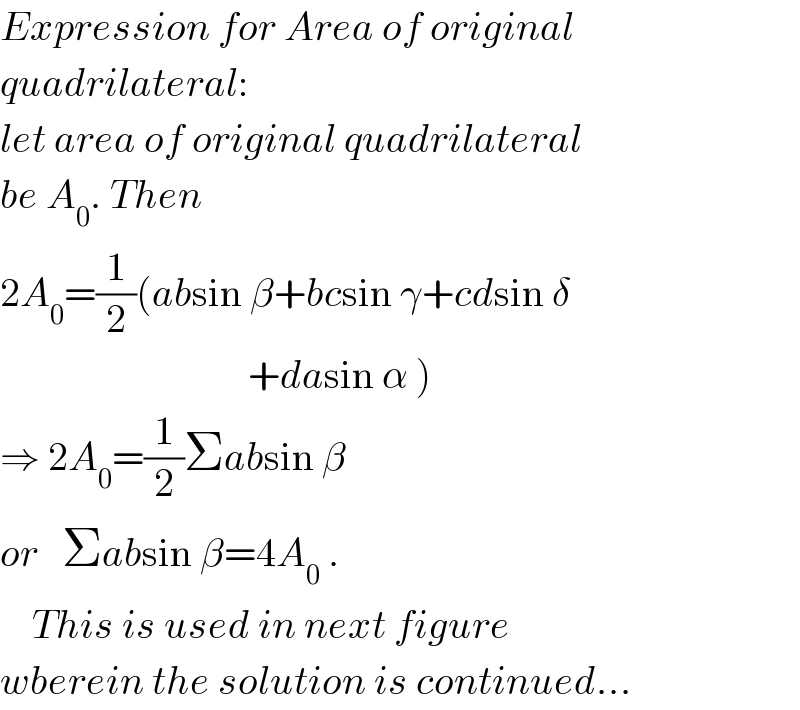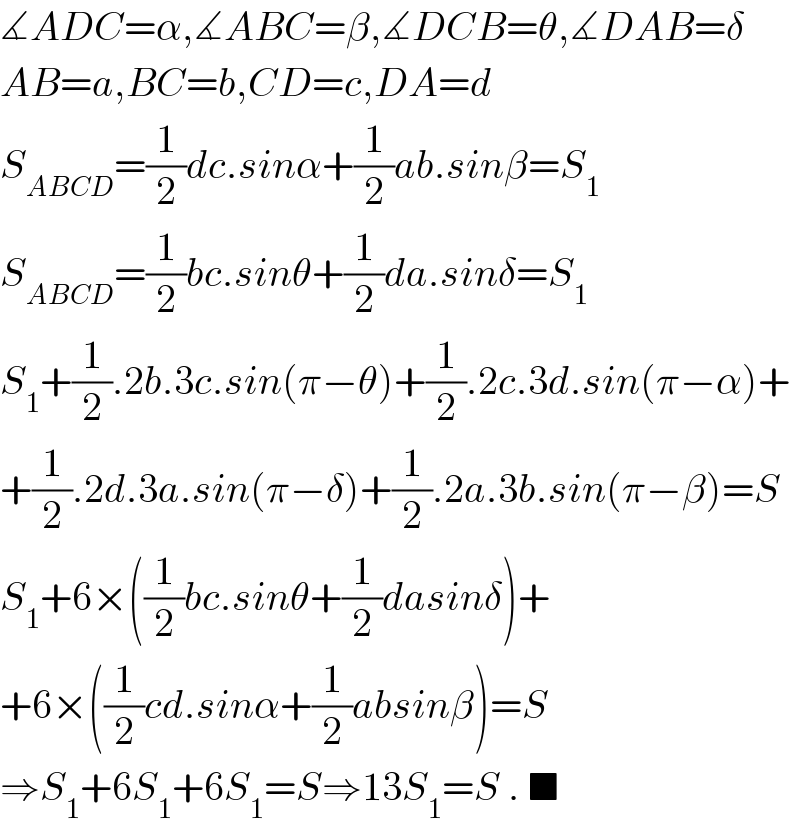
Question Number 15440 by mrW1 last updated on 10/Jun/17

Commented by mrW1 last updated on 10/Jun/17

$$\mathrm{The}\:\mathrm{sides}\:\mathrm{of}\:\mathrm{a}\:\mathrm{convex}\:\mathrm{quadrilateral} \\ $$$$\mathrm{ABCD}\:\mathrm{are}\:\mathrm{elongated}\:\mathrm{2}\:\mathrm{times}\:\mathrm{in}\:\mathrm{one} \\ $$$$\mathrm{direction},\:\mathrm{see}\:\mathrm{diagram},\:\mathrm{to}\:\mathrm{form}\:\mathrm{a}\:\mathrm{new} \\ $$$$\mathrm{quadrilateral}\:\mathrm{EFGH}.\:\mathrm{What}\:\mathrm{is}\:\mathrm{the} \\ $$$$\mathrm{area}\:\mathrm{of}\:\mathrm{the}\:\mathrm{new}\:\mathrm{quadrilateral}\:\mathrm{if}\:\mathrm{the} \\ $$$$\mathrm{area}\:\mathrm{of}\:\mathrm{ABCD}\:\mathrm{is}\:\mathrm{1}. \\ $$$$\mathrm{What}\:\mathrm{is}\:\mathrm{the}\:\mathrm{result},\:\mathrm{if}\:\mathrm{the}\:\mathrm{sides}\:\mathrm{will}\:\mathrm{be} \\ $$$$\mathrm{elongated}\:\mathrm{n}\:\mathrm{times}? \\ $$
Commented by ajfour last updated on 10/Jun/17

$${n}^{\mathrm{2}} +{n}+\mathrm{1} \\ $$$${is}\:{it}\:{correct}\:{sir}\:? \\ $$
Commented by mrW1 last updated on 10/Jun/17

$$\mathrm{no},\:\mathrm{this}\:\mathrm{is}\:\mathrm{not}\:\mathrm{correct}. \\ $$
Commented by ajfour last updated on 10/Jun/17

Commented by ajfour last updated on 10/Jun/17

$${Expression}\:{for}\:{Area}\:{of}\:{original} \\ $$$${quadrilateral}: \\ $$$${let}\:{area}\:{of}\:{original}\:{quadrilateral} \\ $$$${be}\:{A}_{\mathrm{0}} .\:{Then} \\ $$$$\mathrm{2}{A}_{\mathrm{0}} =\frac{\mathrm{1}}{\mathrm{2}}\left({ab}\mathrm{sin}\:\beta+{bc}\mathrm{sin}\:\gamma+{cd}\mathrm{sin}\:\delta\right. \\ $$$$\left.\:\:\:\:\:\:\:\:\:\:\:\:\:\:\:\:\:\:\:\:\:\:\:\:\:\:\:\:\:\:\:+{da}\mathrm{sin}\:\alpha\:\right) \\ $$$$\Rightarrow\:\mathrm{2}{A}_{\mathrm{0}} =\frac{\mathrm{1}}{\mathrm{2}}\Sigma{ab}\mathrm{sin}\:\beta\: \\ $$$${or}\:\:\:\Sigma{ab}\mathrm{sin}\:\beta=\mathrm{4}{A}_{\mathrm{0}} \:. \\ $$$$\:\:\:\:{This}\:{is}\:{used}\:{in}\:{next}\:{figure} \\ $$$${wberein}\:{the}\:{solution}\:{is}\:{continued}... \\ $$
Commented by ajfour last updated on 10/Jun/17

Commented by ajfour last updated on 10/Jun/17
![let area of new quadrilateral be S. S=A_0 +(1/2)[ na(n+1)bsin β +nb(n+1)csin γ +nc(n+1)dsin δ +nd(n+1)asin α ] ⇒ S=A_0 +((n(n+1))/2) Σabsin β it has been found in previous comment that Σabsin β=4A_0 , therefore S=A_0 +((n(n+1))/2)(4A_0 ) S=A_0 (1+2n^2 +2n) or (S/A_0 ) =2n^2 +2n+1 .](Q15466.png)
$${let}\:{area}\:{of}\:{new}\:{quadrilateral} \\ $$$${be}\:{S}. \\ $$$$\:{S}={A}_{\mathrm{0}} +\frac{\mathrm{1}}{\mathrm{2}}\left[\:{na}\left({n}+\mathrm{1}\right){b}\mathrm{sin}\:\beta\right. \\ $$$$\:\:\:\:\:\:\:\:\:+{nb}\left({n}+\mathrm{1}\right){c}\mathrm{sin}\:\gamma \\ $$$$\:\:\:\:\:\:\:\:\:\:+{nc}\left({n}+\mathrm{1}\right){d}\mathrm{sin}\:\delta \\ $$$$\left.\:\:\:\:\:\:\:\:\:\:+{nd}\left({n}+\mathrm{1}\right){a}\mathrm{sin}\:\alpha\:\right] \\ $$$$\Rightarrow\:{S}={A}_{\mathrm{0}} +\frac{{n}\left({n}+\mathrm{1}\right)}{\mathrm{2}}\:\Sigma{ab}\mathrm{sin}\:\beta \\ $$$${it}\:{has}\:{been}\:{found}\:{in}\:{previous} \\ $$$${comment}\:{that}\:\Sigma{ab}\mathrm{sin}\:\beta=\mathrm{4}{A}_{\mathrm{0}} \:, \\ $$$${therefore}\: \\ $$$$\:\:\:\:\:\:\:\:\:\:\:\:{S}={A}_{\mathrm{0}} +\frac{{n}\left({n}+\mathrm{1}\right)}{\mathrm{2}}\left(\mathrm{4}{A}_{\mathrm{0}} \right) \\ $$$$\:\:\:\:\:\:\:\:\:\:\:\:{S}={A}_{\mathrm{0}} \left(\mathrm{1}+\mathrm{2}{n}^{\mathrm{2}} +\mathrm{2}{n}\right) \\ $$$$\:\:\:\:{or}\:\:\:\:\frac{{S}}{{A}_{\mathrm{0}} }\:=\mathrm{2}{n}^{\mathrm{2}} +\mathrm{2}{n}+\mathrm{1}\:. \\ $$
Commented by mrW1 last updated on 10/Jun/17

$$\mathrm{Answer}\:\mathrm{2n}^{\mathrm{2}} +\mathrm{2n}+\mathrm{1}\:\mathrm{is}\:\mathrm{correct}! \\ $$
Commented by ajfour last updated on 10/Jun/17

$${with}\:\:{n}=\mathrm{2}\:,\:\:\frac{{S}}{{A}_{\mathrm{0}} }\:=\:\mathrm{13}\:. \\ $$
Answered by b.e.h.i.8.3.4.1.7@gmail.com last updated on 11/Jun/17

$$\measuredangle{ADC}=\alpha,\measuredangle{ABC}=\beta,\measuredangle{DCB}=\theta,\measuredangle{DAB}=\delta \\ $$$${AB}={a},{BC}={b},{CD}={c},{DA}={d} \\ $$$${S}_{{ABCD}} =\frac{\mathrm{1}}{\mathrm{2}}{dc}.{sin}\alpha+\frac{\mathrm{1}}{\mathrm{2}}{ab}.{sin}\beta={S}_{\mathrm{1}} \\ $$$${S}_{{ABCD}} =\frac{\mathrm{1}}{\mathrm{2}}{bc}.{sin}\theta+\frac{\mathrm{1}}{\mathrm{2}}{da}.{sin}\delta={S}_{\mathrm{1}} \\ $$$${S}_{\mathrm{1}} +\frac{\mathrm{1}}{\mathrm{2}}.\mathrm{2}{b}.\mathrm{3}{c}.{sin}\left(\pi−\theta\right)+\frac{\mathrm{1}}{\mathrm{2}}.\mathrm{2}{c}.\mathrm{3}{d}.{sin}\left(\pi−\alpha\right)+ \\ $$$$+\frac{\mathrm{1}}{\mathrm{2}}.\mathrm{2}{d}.\mathrm{3}{a}.{sin}\left(\pi−\delta\right)+\frac{\mathrm{1}}{\mathrm{2}}.\mathrm{2}{a}.\mathrm{3}{b}.{sin}\left(\pi−\beta\right)={S} \\ $$$${S}_{\mathrm{1}} +\mathrm{6}×\left(\frac{\mathrm{1}}{\mathrm{2}}{bc}.{sin}\theta+\frac{\mathrm{1}}{\mathrm{2}}{dasin}\delta\right)+ \\ $$$$+\mathrm{6}×\left(\frac{\mathrm{1}}{\mathrm{2}}{cd}.{sin}\alpha+\frac{\mathrm{1}}{\mathrm{2}}{absin}\beta\right)={S} \\ $$$$\Rightarrow{S}_{\mathrm{1}} +\mathrm{6}{S}_{\mathrm{1}} +\mathrm{6}{S}_{\mathrm{1}} ={S}\Rightarrow\mathrm{13}{S}_{\mathrm{1}} ={S}\:.\:\blacksquare \\ $$
Answered by b.e.h.i.8.3.4.1.7@gmail.com last updated on 11/Jun/17

$${in}\:{case}\:{of}:\:{n} \\ $$$${S}_{\mathrm{1}} +\mathrm{2}{n}\left({n}+\mathrm{1}\right){S}_{\mathrm{1}} ={S} \\ $$$$\Rightarrow\frac{{S}}{{S}_{\mathrm{1}} }=\mathrm{2}{n}^{\mathrm{2}} +\mathrm{2}{n}+\mathrm{1}\:.\blacksquare \\ $$
Commented by mrW1 last updated on 11/Jun/17

$$\mathrm{That}'\mathrm{s}\:\mathrm{right}. \\ $$
Answered by mrW1 last updated on 11/Jun/17
![I have an other solution without using trigonometry and analytic geometry: A_(ΔBCF) =nA_(ΔACB) A_(ΔBGF) =(n+1)A_(ΔBCF) =(n+1)nA_(ΔACB) similarly A_(ΔDEH) =(n+1)nA_(ΔACD) ⇒A_(ΔBGF) +A_(ΔDEH) =(n+1)n(A_(ΔACB) +A_(ΔACD) )=(n+1)nA_(ABCD) similarly ⇒A_(ΔCHG) +A_(ΔAFE) =(n+1)n(A_(ΔCDB) +A_(ΔADB) )=(n+1)nA_(ABCD) A_(EFGH) =A_(ΔBGF) +A_(ΔDEH) +A_(ΔBGF) +A_(ΔDEH) +A_(ABCD) =2(n+1)nA_(ABCD) +A_(ABCD) =[2n(n+1)+1]A_(ABCD) =2n(n+1)+1 =2n^2 +2n+1](Q15502.png)
$$\mathrm{I}\:\mathrm{have}\:\mathrm{an}\:\mathrm{other}\:\:\mathrm{solution}\:\mathrm{without}\:\mathrm{using} \\ $$$$\mathrm{trigonometry}\:\mathrm{and}\:\mathrm{analytic}\:\mathrm{geometry}: \\ $$$$ \\ $$$$\mathrm{A}_{\Delta\mathrm{BCF}} =\mathrm{nA}_{\Delta\mathrm{ACB}} \\ $$$$\mathrm{A}_{\Delta\mathrm{BGF}} =\left(\mathrm{n}+\mathrm{1}\right)\mathrm{A}_{\Delta\mathrm{BCF}} =\left(\mathrm{n}+\mathrm{1}\right)\mathrm{nA}_{\Delta\mathrm{ACB}} \\ $$$$ \\ $$$$\mathrm{similarly} \\ $$$$\mathrm{A}_{\Delta\mathrm{DEH}} =\left(\mathrm{n}+\mathrm{1}\right)\mathrm{nA}_{\Delta\mathrm{ACD}} \\ $$$$ \\ $$$$\Rightarrow\mathrm{A}_{\Delta\mathrm{BGF}} +\mathrm{A}_{\Delta\mathrm{DEH}} =\left(\mathrm{n}+\mathrm{1}\right)\mathrm{n}\left(\mathrm{A}_{\Delta\mathrm{ACB}} +\mathrm{A}_{\Delta\mathrm{ACD}} \right)=\left(\mathrm{n}+\mathrm{1}\right)\mathrm{nA}_{\mathrm{ABCD}} \\ $$$$ \\ $$$$\mathrm{similarly} \\ $$$$\Rightarrow\mathrm{A}_{\Delta\mathrm{CHG}} +\mathrm{A}_{\Delta\mathrm{AFE}} =\left(\mathrm{n}+\mathrm{1}\right)\mathrm{n}\left(\mathrm{A}_{\Delta\mathrm{CDB}} +\mathrm{A}_{\Delta\mathrm{ADB}} \right)=\left(\mathrm{n}+\mathrm{1}\right)\mathrm{nA}_{\mathrm{ABCD}} \\ $$$$ \\ $$$$\mathrm{A}_{\mathrm{EFGH}} =\mathrm{A}_{\Delta\mathrm{BGF}} +\mathrm{A}_{\Delta\mathrm{DEH}} +\mathrm{A}_{\Delta\mathrm{BGF}} +\mathrm{A}_{\Delta\mathrm{DEH}} +\mathrm{A}_{\mathrm{ABCD}} \\ $$$$=\mathrm{2}\left(\mathrm{n}+\mathrm{1}\right)\mathrm{nA}_{\mathrm{ABCD}} +\mathrm{A}_{\mathrm{ABCD}} \\ $$$$=\left[\mathrm{2n}\left(\mathrm{n}+\mathrm{1}\right)+\mathrm{1}\right]\mathrm{A}_{\mathrm{ABCD}} \\ $$$$=\mathrm{2n}\left(\mathrm{n}+\mathrm{1}\right)+\mathrm{1} \\ $$$$=\mathrm{2n}^{\mathrm{2}} +\mathrm{2n}+\mathrm{1} \\ $$
Commented by mrW1 last updated on 11/Jun/17

Commented by b.e.h.i.8.3.4.1.7@gmail.com last updated on 11/Jun/17

$${nice}\:\&\:{smart}.\:{but}:\:{n}^{\mathrm{2}} +\mathrm{2}{n}+\mathrm{1}\:\left({or}\:\mathrm{2}\right)? \\ $$
Commented by mrW1 last updated on 11/Jun/17

$$\mathrm{thank}\:\mathrm{you}!\:\mathrm{2n}^{\mathrm{2}} +\mathrm{2n}+\mathrm{1}\:\mathrm{is}\:\mathrm{correct}. \\ $$
